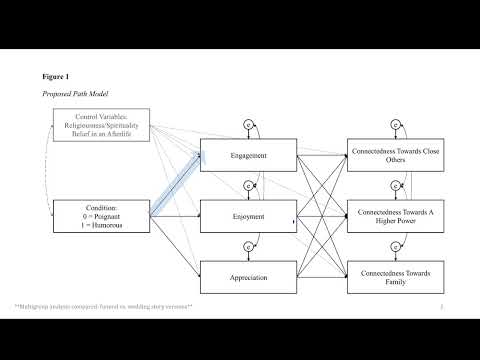 Speaker: Kaitlin Fitzgerald @Katie_Fitzgerald
Speaker: Kaitlin Fitzgerald @Katie_Fitzgerald
 Affiliation: Cornell University
Affiliation: Cornell University
 Co-authors: Charles J. Francemone and Matthew Grizzard
Co-authors: Charles J. Francemone and Matthew Grizzard
Title: Testing Narrative Tone and Context in Self-Transcendent Media
Abstract (long version below): This study aimed to identify measurable types of self-transcendent media content by varying narrative tone (humorous vs. poignant) and context (wedding vs. funeral). Four story versions were created and tested for their effects on connectedness through narrative engagement, enjoyment, and appreciation. Utilizing a path model and multigroup analysis, the study found consistent levels of connectedness across the story versions, pointing to the role of the subjective audience experience rather than of the particular content elements.

 Long abstract
Long abstract
Over the past decade, communication research has increasingly focused on the positive societal and personal impacts of media, particularly through “meaningful media” experiences that elicit connectedness, moral virtue, and spirituality (Oliver et al., 2018). These experiences, termed “self-transcendent media,” often foster universalism and interconnectedness. However, Oliver et al. (2018) questioned whether self-transcendent media could be clearly identified and measured. Seeking to address this, we explored how narrative tone (humorous vs. poignant) and context (funeral vs. wedding) influence connectedness, a core outcome of self-transcendent media. Using an experimental design, we manipulated narrative tone and context in a single story to create four versions. In a path model, we assessed how these narrative features influence narrative engagement, enjoyment, and appreciation, which in turn impact connectedness. We examined connectedness across three dimensions: close others, family, and a higher power (Janicke & Oliver, 2017). Additionally, due to their associations with connectedness, we included religiousness and belief in an afterlife as control variables.
Method
Participants and Procedure
We used a 2x2 experimental design with Narrative Tone (Poignant vs. Humorous) and Narrative Context (Funeral vs. Wedding) as factors. Participants (N = 247) were recruited via CloudResearch and randomly assigned to one of the four story conditions. After reading their assigned narrative, participants completed measures and demographic items. Exclusions included those who had not experienced the loss of a loved one or failed the manipulation check. A chi-square test confirmed random assignment was unaffected, χ² = 0.04, p = .848.
Measures
Narrative Engagement. Consistent with past research (Fitzgerald et al., 2022), emotional flow, transportation, and identification were assessed with validated scales and combined into a reliable composite (α = 0.93, ⍵ = .92). Initial confirmatory factor analysis (CFA) revealed poor fit, but item adjustments improved model fit (χ² = 323.11(51), CFI = 0.93, SRMR = .07).
Enjoyment and Appreciation. We utilized Oliver & Bartsch’s (2010) 3-item scales for enjoyment (α = 0.94) and appreciation (α = 0.89), which demonstrated good reliability and CFA fit (χ² = 56.59(8), CFI = 0.98, SRMR = .05).
Connectedness. Connectedness was measured across three subscales: close others, higher power, and family. CFA results led to selective item retention, resulting in well-fitting models and strong reliability for all subscales (α ≥ 0.96).
Religiousness/Spirituality and Belief in Afterlife. Single items assessed religiousness/spirituality and belief in an afterlife on Likert scales.
Results
First, our base model fit well, χ²(3) = 0.58, CFI = 1.00, SRMR = .00, indicating overall consistency in processes across conditions. However, multigroup analysis revealed differences in the magnitude of paths, particularly in how tone and context influenced narrative outcomes (unconstrained, χ²(6) = 8.59, CFI = 1.00, SRMR = .02; with structural weights constrained, Δχ²(24) = 39.68, p = .023).
In particular, humorous tones increased enjoyment in funerals (p < .001) but not in weddings (p = .345). Across contexts, humorous tones decreased appreciation (Funeral: p = .049; Wedding: p = .002), aligning with lower perceptions of eudaimonia. Engagement predicted all subcomponents of connectedness, strongest in funerals (e.g., β = .41 for close others, compared to β = .14 in weddings). Enjoyment had minimal impact on connectedness, except close others in weddings (p < .001). Appreciation consistently predicted connectedness across conditions (smallest p = .033).
Interestingly, correlations between enjoyment and appreciation were stronger in weddings (r = .78) than funerals (r = .39), suggesting distinct narrative appraisals based on context. Connectedness subcomponents were interrelated in funerals but diverged in weddings. No indirect effects of tone were observed, underscoring engagement and appreciation as central to connectedness and self-transcendence.
Discussion
This study examined how narrative tone (humorous or poignant) and context (wedding or funeral) influence self-transcendent media experiences, particularly feelings of connectedness. The results showed that narrative tone affected enjoyment and appreciation, but its impact on connectedness was minimal. Humor increased enjoyment in the funeral context but decreased appreciation across both contexts. Narrative engagement consistently predicted connectedness, with a stronger effect in the funeral context. Appreciation was the most significant predictor of connectedness, underscoring its importance in fostering self-transcendent experiences.
Our findings suggest that the tone and context of narrative content have less impact on connectedness than the audience’s subjective experience. Although we observed some differences in narrative outcomes, these were nuanced across contexts and did not significantly affect connectedness overall. This supports the idea that self-transcendent media experiences depend more on personal engagement than on specific content characteristics.
Future research should explore more varied content elements, such as moral virtue, and test transcendence across different media types, including film and social media. Additionally, longitudinal studies could examine the long-term effects of repeated exposure to self-transcendent media. Overall, these findings suggest that fostering engagement and eudaimonic responses is key to designing narratives that promote connectedness and self-transcendence.


